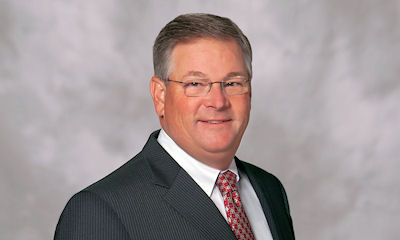June 19, 2015

The president and chief operating officer of Monsanto has farmers firmly in mind when he talks about the company's business. Brett Begemann, who came up through the ranks to his current position, says anything Monsanto does has to make sense for the customer. "Our goal is to be the farmers' preferred supplier," he says. "We're out of business without them."

Brett Begemann, president and chief operating officer, Monsanto, talks about that company's move to acquire Syngenta and what it means for farmers. (Photo/Monsanto)
Helping farmers meet the rising challenges to ag productivity is a key driver for Monsanto's move to acquire Syngenta - a twice rebuffed effort that's still under negotiation. Begemann talked with Penton Agriculture about the issue and what it means for farmers. In a frank discussion he shared answers to a range of questions surrounding the proposed merger.
One issue that may have been a source of frustration for Monsanto management is Syngenta's management tactic of releasing letters from Monsanto to Syngenta outlining proposed details of any merger.
"They're out there now, they're public," Begemann says. "We don't have a problem with that." Yet it's a tactic that shined a light on the talks between the two companies that he says has been going on for a few years.
Merger details
First up is the seed business at Syngenta. Speculation has noted that for Monsanto make the acquisition, Syngenta's seeds and traits businesses must be spun off to satisfy regulators.
Begemann says that decision isn't regulator driven: "From early on in the discussions we've been interested in selling the seed and traits businesses, and it's not about antitrust. It's about what we needed to with our already strong seed and trait portfolio. We were going to [sell that] anyway."
Related: Five things HBO's Vice got wrong in their attack on Monsanto
In fact any duplication between the two companies will be unbundled in a final Monsanto-Syngenta merged entity, including overlapping crop protection lines. For example, Syngenta has its own glyphosate formulation - Touchdown - which would go. And Syngenta uses metolachlor chemistry while Monsanto markets acetochlor.
"Once we get rid of the overlap [in seeds and crop protection] this is a really straightforward deal," Begemann says. And he adds that the company is committed to work through the regulatory process too.
~~~PAGE_BREAK_HERE~~~
Second is talk of the idea of a "redomicile" of Monsanto - a move that was popular recently as a way to lower U.S. taxes by acquiring a company in a lower-tax region and changing a corporate ownership to that new location. Begemann explains that any new company would be run from St. Louis. "Today we're a Delaware corporation with headquarters in St. Louis," he notes.
In one of the letters Syngenta shared from the companies' talks the idea was floated that a neutral site for domicile might be selected.
Related: Monsanto's Fraley discusses Ag's innovations and challenges
"We shared that we would be open to a neutral site domicile. We've been talking for a couple of years and if they don't like our name and we don't want to use their's let's go neutral, new name for this company, and drive value," he says.
Begemann explains that the combined company would have a significant presence all over the world, including Europe. "It only makes sense to have a significant presence in that part of the world too," he notes. "We will continue to be in St. Louis. But these are negotiating points to address concerns of shareowners."
Why merge?
Yet the over-riding question on this whole issue is why merge at all? "We've been looking at this space for some time and we have the challenge of feeding 9.5 billion people by 2050," Begemann says. "We need to meet that need in a sustainable way and we need to drive sustainable intensification of agriculture."
Precision agriculture, data science, microbials, biotech traits, breeding, crop protection innovation - Monsanto sees that it will take all of those tools applied together to meet this growing food challenge.
"Syngenta has a nice crop protection portfolio and scientific development tools, the things we need to bring these solutions to farmers. If farmers are going to drive productivity and feed the world, they're going to need new tools and new ways of doing it," he says.
A running comment made by some media outlets was that Monsanto was "returning" to crop protection after years of focusing on seeds and traits. Begemann doesn’t see it that way.
"I think it's one of those things from what you see inside the company than outside. We have the largest ag crop protection molecule in the market - we call it Roundup," he notes. "Our acetanilide chemistry is in the top five and with the advent of our Xtend technology dicamba will be big too. And we're the largest distributor of seed protectants."
~~~PAGE_BREAK_HERE~~~
He says that Monsanto has always looked at crop protection as an important tool for farmers along with biotech and seed. This merger will bring together an even stronger portfolio and research capability for the future.
One concern raised by some is that the merger would reduce choice in the market. Begemann is adamant that this won't be true. "The choices in the market today will exist after this merger," he says. The key here is that the seeds and traits businesses would we sold to another firm and those choices would still exist in the market. In addition, any crop protection sold off would also still be available.
And Begemann says Monsanto has always been about creating choices and making technology available to others noting that key competitors including Pioneer have access to Monsanto's "best stuff."
Continued talks
Syngenta management has twice rebuffed Monsanto. The initial offer was a share purchase offer with a 43% premium over the market value. The second offer, also rejected, rolled in a $2 billion break-up fee if the deal went sour after moving forward in good faith.
Begemann says the work now is to talk with shareowners of Syngenta, who can have a significant impact on company management, asking about the merger. "We've been talking to share-owners for the last two weeks and they're asking management the same questions," he says.
Begemann notes that not only would Syngenta share-owners get that bump in value, but the proposal, which consists of 55% stock and 45% cash, providing Syngenta shareholders with 30% ownership in the combined entity. "They're excited about that too," he notes.
Related: Chicago moms are more accepting of GMOs after touring Monsanto's research facility
Yet during the conversation Begemann kept going back to the farmer. "First, our farmers have to be supportive of this and it has to make sense to them or it won't work," Begemann says.
It's been some time since major players in the ag space have merged. Begemann says that in the past few years he's been watching farmer-customers consolidate in the field. There's also been consolidation in distribution, but not in basic manufacturing for a long time.
"It was inevitable, it's going to happen," he says. "The challenges ag has to address in the next 30 to 50 years will require significant investment."
Monsanto isn't walking away, that message is clear.
About the Author(s)
You May Also Like






